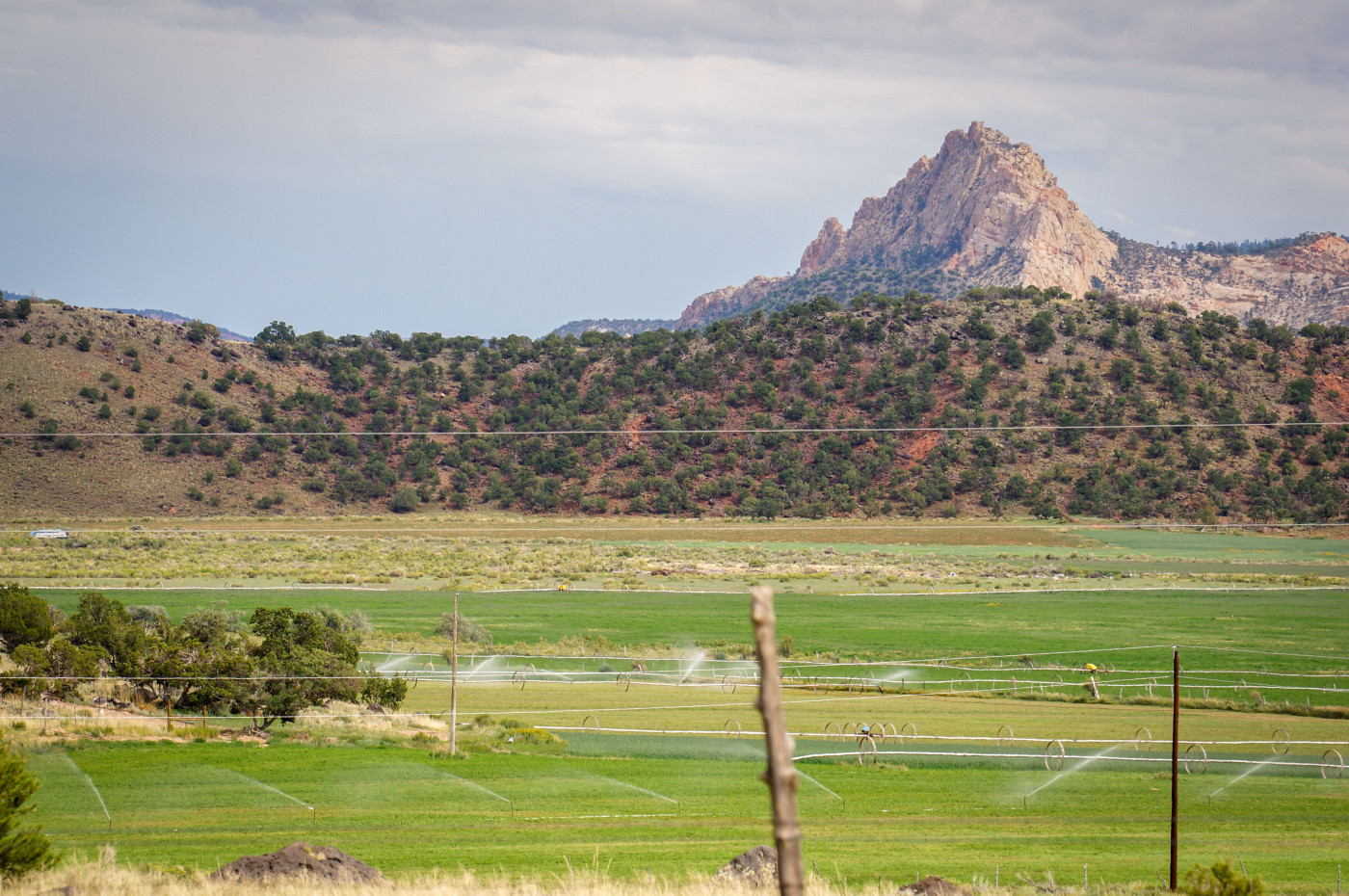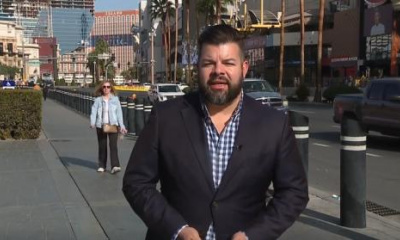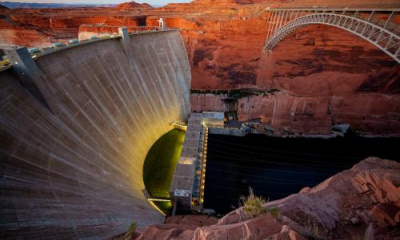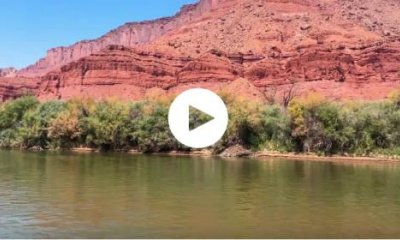BOULDER — South-central Utah is not your typical farm country. To the eye, there appears to be more red rock than green fields
To make a go of it, farms often huddle around the precious few rivers that snake across the sun-baked landscape. That’s the case for rancher Andy Rice, who raises hundreds of hungry goats and sheep in the Garfield County town of Boulder — population 227 — just outside Grand Staircase-Escalante National Monument.
Listen to the audio story here.
There’s no mistaking how dry it is. The area averages less than 12 inches of annual precipitation. The edges of Rice’s lush green pasture give way to a rugged sandstone ridge.

Andy Rice holds one of the nozzles on a center pivot irrigation system his ranch was able to install thanks to state money, Aug. 21, 2024. Utah’s Agricultural Water Optimization Program has put millions of dollars into helping farmers and ranchers modernize their irrigation systems since 2019. (David Condos, KUER)
So the grazing smorgasbord depends on irrigation and farming practices that make the most of that moisture. This ranch draws water from Boulder Creek that would otherwise be on its way to Lake Powell.
Between drought and competition for the Colorado River, however, Rice knows that Utah’s water supply faces a precarious future. That means ranches like his will need to find ways to cut their water use to survive.
“We will have less water. Forever,” Rice said. “We have to accept that and … it’s up to us to be more efficient.”
That’s why Rice applied for funding from Utah’s Agricultural Water Optimization Program — a big money push to help farmers and ranchers modernize their irrigation. With roughly three-fourths of the state’s water going to agriculture, the situation has put a bullseye on farming when it comes to stretching that H20. Utah is counting on the program — which covers half the cost of buying new, more efficient gear — to save more water for communities, rivers and reservoirs downstream.
As he stood next to a center pivot irrigation system the program helped pay for, Rice reached for one of the dozens of spray nozzles that dangle a few feet over the ground. Compared to the equipment it replaced, he said, the difference is night and day.

Andy Rice explains how the irrigation tech upgrades at his ranch have helped save water, Aug. 21, 2024. (David Condos, KUER)
“This farm alone has saved millions of gallons of water. We’re using millions less. And we are one tiny farm in one tiny region,” Rice said.
“If hundreds of farms can save millions of gallons of water, I mean, we can fix it. … And do I feel like we have a responsibility to do that? Yeah, hell yeah.”
That’s the idea behind Utah’s optimization program. If state money lowers the financial barrier for farmers to upgrade, the water savings might add up to help Utah maximize the little moisture it has.
Rice is just one example of the state’s approved projects, 551 of them and counting, said Program Manager Hannah Freeze, since the program began in 2019. The Utah Legislature has allocated $276 million so far and $108 million has gone to approved projects. A majority of that money is flowing toward the Great Salt Lake — $23 million has been approved for 112 projects in Utah’s Colorado River Basin.
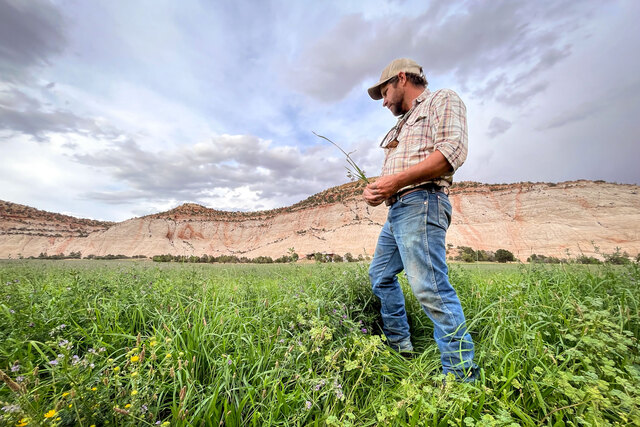
Rancher Andy Rice plucks a handful of plants from one of his pastures in Garfield County, Aug. 21, 2024 (David Condos, KUER)
It’s a good start, Freeze said, but a drop in the bucket compared to what it might take to significantly improve Utah’s water outlook.
“If we were going to make a real dent or reach the majority of the farmers that we have, it’s more like a $2 billion number.”
It would take time, too, she said, probably around three decades.
Growing the program that much won’t be easy. For one, Freeze said, it would need continued support from lawmakers.
It’ll also take some work to get a majority of farmers on board. Many don’t know of the government incentives available. A 2023 survey of Colorado River Basin irrigators by the Western Landowners Alliance and the University of Wyoming found a “stark lack of awareness” about state and federal funding meant to help them conserve water. Some are hesitant to change farming practices they’ve done for decades. For others, equipment cost remains a barrier — even with the program’s help.
Dick Pace farms alfalfa to feed his cattle in the Wayne County town of Teasdale, population 140. It’s a spot of green surrounded by red and white rock formations in the Fremont River valley near Capitol Reef National Park.
And it can get a bit breezy.
“I think when [the pioneers] showed up, they decided to rest, and they said, ‘We’ll stop until the wind quits,’” Pace said. “And it never quit.”
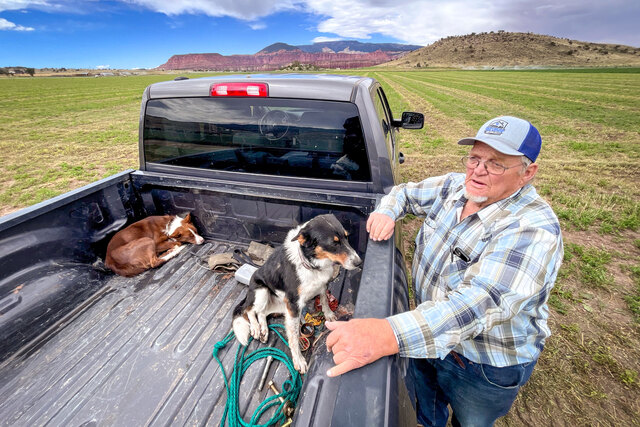
Wayne County farmer Dick Pace stands next to one of his alfalfa fields with his cow dog, Annie, Aug. 22, 2024. If he can get some additional funding, he hopes to replace the field’s wheel line irrigation with a more efficient system by next year. (David Condos, KUER)
His fields are irrigated by wheel lines — long pipes held up by metal wagon wheels several feet tall. They typically release water with impact sprinklers, like the ones that make the classic clicking noise when people water their lawns. They are a common sight on farms and ranches across Utah, but many are decades old and prone to leaks.
Older irrigation systems like wheel lines tend to throw water up into the air, which means they can lose quite a bit to evaporation — especially on those windswept days.
“You could just see a mist of that water leaving,” Pace said, remembering that common sight. “I don’t know where it was going. It’s just leaving.”
Even though Pace is approved for optimization program funds for a more efficient system, the remaining price tag — he said it’d be around $50,000 — is still too steep. He hopes some additional federal money he applied for can help make the project a reality before the state money expires in the spring of 2025.
“We’re just trying to make a living,” Pace said. “And if some [water] goes by, well, we don’t feel too bad about that either.”
Farmers eventually won’t have a choice, noted Hannah Freeze. Pressures from drought, climate change and development mean more people are fighting over a shrinking Colorado River system, so Utah agriculture will need to adapt or face extinction.
“There’s going to be water reductions that have to take place,” Freeze said. “So if we can come in first and say, ‘Let us help you get this improved irrigation system,’ then our farmers can stay in business.”
The less water farmers use, the more water has a chance to flow into rivers and Lake Powell. That is if it isn’t used up by other water rights holders downstream first. Historically, Utahns who didn’t take advantage of their full water rights risked forfeiting that unused portion. It’s known as the “use it or lose it” policy. Recent legislation, however, makes it easier for farmers to retain the rights to water they conserve to boost streamflows.
When it comes to statewide results, however, the picture is still a bit hazy.
The optimization program is just beginning to quantify how much water these projects save — meaning the portion of the water right that’s no longer being used — so the cumulative data isn’t clear yet. A legislative audit in 2023 criticized the program for not collecting detailed reports on the impact of its projects.
“Our Legislature wants to know what those acre-feet of water are in saved water, and we’re barely getting started,” Freeze said. “We’re just scratching the surface.”
Lawmakers and the program also haven’t yet set specific goals for how much water Utah wants to save per dollar spent, she said.
Early examples like Andy Rice’s ranch, however, point to the potential.
In addition to the new center pivot sprinkler, state money also helped the ranch update the nozzles on its other sprayers and allow Rice to manage it all remotely, which helps prevent overwatering. The ranch has also put in soil moisture sensors with help from a different program to get real-time data about when the ground needs water and when it doesn’t.
He estimates his ranch has improved its water efficiency by around 20% compared to the old equipment. As he continues to build up the ranch’s soil health — something the diverse mixture of plants in his pasture helps with — he believes his dirt will soon hold onto moisture even better than it does today. Two years from now, he expects to use around half the water to achieve the same growth.
“It’s using water more efficient than my grandpa did, way more efficient than I did when I started,” Rice said.
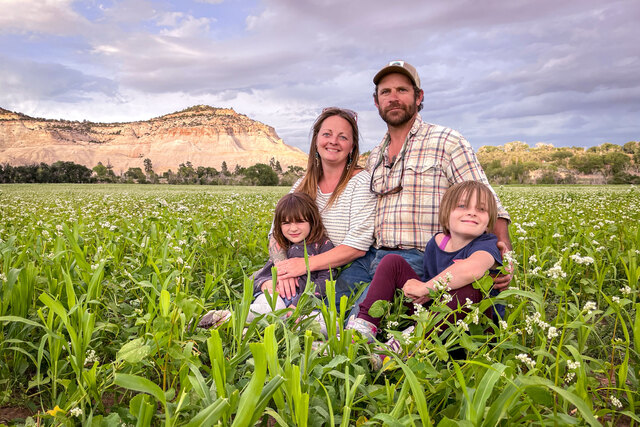
Andy and Andria Rice sit with their daughters Carmen, right, and Shirley, left, in one of the fields at Boulder Creek Canyon Ranch, Aug. 21, 2024. (David Condos, KUER)
All told, Rice said the upgrades to this one field alone represent a quarter of a million dollars of investment. For family farms that buy irrigation systems with the same money they use to keep the business afloat or buy their kids’ shoes, he said it can be hard to justify those costs.
If state help can make it easier for more farmers to take that leap, however, that could have far-reaching impacts.
“It’s totally realistic to think that if everybody got on board and got more efficient — and if systems were put in place to show a farmer that he can be as profitable or more profitable using less water — billions of gallons can be restored to the [watershed] system.”
Contributing: Mark Wetzel and Shelby Lofton, KSL TV

